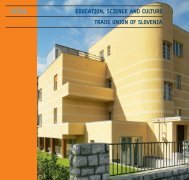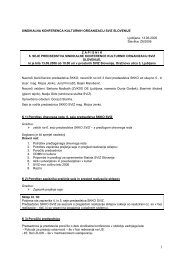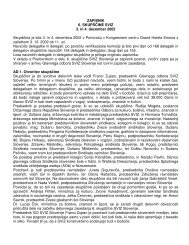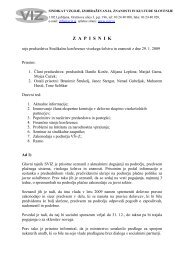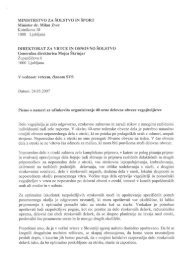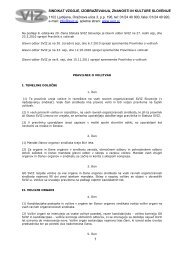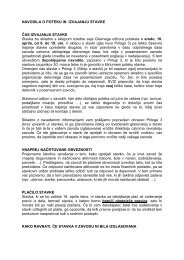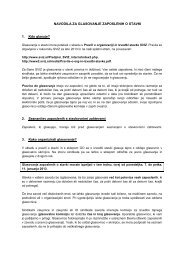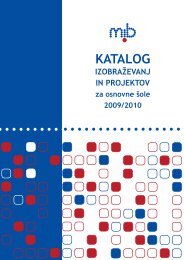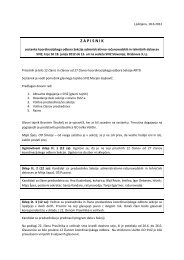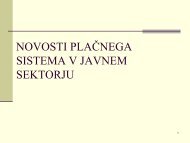The use and misuse of teacher appraisal - Education International
The use and misuse of teacher appraisal - Education International
The use and misuse of teacher appraisal - Education International
You also want an ePaper? Increase the reach of your titles
YUMPU automatically turns print PDFs into web optimized ePapers that Google loves.
T H E U S E A N D M I S U S E O F T E A C H E R A P P R A I S A L<br />
Box 3: <strong>The</strong> <strong>use</strong> <strong>of</strong> pr<strong>of</strong>essional st<strong>and</strong>ards in the US<br />
Pr<strong>of</strong>essional st<strong>and</strong>ards defining accomplished teaching were first developed by the National Board<br />
for Pr<strong>of</strong>essional Teaching St<strong>and</strong>ards to guide assessments for veteran <strong>teacher</strong>s. Subsequently,<br />
a group <strong>of</strong> states working together under the auspices <strong>of</strong> the Council for Chief State School Officers<br />
created the Interstate New Teacher Assessment <strong>and</strong> Support Consortium (InTASC), which<br />
translated these into st<strong>and</strong>ards for new <strong>teacher</strong>s, adopted by over 40 states for initial <strong>teacher</strong><br />
licensing. A recent revision <strong>of</strong> the InTASC teaching st<strong>and</strong>ards has been aligned with the Common<br />
Core St<strong>and</strong>ards in order to reflect the kind <strong>of</strong> <strong>teacher</strong> knowledge, skills, <strong>and</strong> underst<strong>and</strong>ings needed<br />
to enact the st<strong>and</strong>ards. <strong>The</strong>se st<strong>and</strong>ards have become the basis for assessments <strong>of</strong> teaching that<br />
produce ratings which are much more stable than value-added measures. At the same time, they<br />
incorporate classroom evidence <strong>of</strong> student learning <strong>and</strong> they have recently been shown in largerscale<br />
studies to predict <strong>teacher</strong>s’ value-added effectiveness, thus grounding evaluation in<br />
student learning. Typically, the performance assessments ask <strong>teacher</strong>s to document their plans<br />
<strong>and</strong> teaching within a unit <strong>of</strong> instruction which is linked to the state st<strong>and</strong>ards. Teachers are asked<br />
to adapt them for special education students <strong>and</strong> English language learners, videotape <strong>and</strong> critique<br />
lessons, <strong>and</strong> collect <strong>and</strong> evaluate evidence <strong>of</strong> student learning.<br />
A number <strong>of</strong> studies have found that the National Board Certification assessment process<br />
identifies <strong>teacher</strong>s who are more effective in raising student achievement than other <strong>teacher</strong>s.<br />
Equally important, studies have found that <strong>teacher</strong>s’ participation in the National Board process<br />
stimulates improvements in their practice. Similar performance assessments, <strong>use</strong>d with new <strong>teacher</strong>s<br />
in Connecticut <strong>and</strong> California, have been found to predict their students’ achievement gains on<br />
state tests. <strong>The</strong> Performance Assessment for California Teachers (PACT) has also been found to<br />
improve beginning <strong>teacher</strong>s’ competence <strong>and</strong> to stimulate improvements in the <strong>teacher</strong> education<br />
programmes that <strong>use</strong> it as a measure.<br />
Source: Strauss, 2011; Darling-Hammond, 2011<br />
<strong>The</strong> <strong>appraisal</strong> impact varies across jurisdictions. It can affect career <strong>and</strong> leadership<br />
opportunities in some jurisdictions, whilst having little to no impact on career<br />
advancement in others. Linking <strong>teacher</strong> <strong>appraisal</strong> to <strong>teacher</strong> pay is just beginning to<br />
take hold in a small number <strong>of</strong> jurisdictions across the US, despite mounting opposition<br />
from <strong>teacher</strong>s <strong>and</strong> researchers.<br />
Most <strong>teacher</strong> <strong>appraisal</strong> systems in the US include appeal procedures, even if these may<br />
differ significantly depending on whether the <strong>appraisal</strong> systems are collectively<br />
bargained or whether they have come about as a result <strong>of</strong> ‘meet <strong>and</strong> confer’. As jurisdictions<br />
seek to streamline the appeal process <strong>and</strong> make it transparent, <strong>teacher</strong> unions believe<br />
that some procedures are being eroded or eliminated.<br />
Initially, <strong>teacher</strong> <strong>appraisal</strong> systems were more compliance-oriented, <strong>and</strong> <strong>teacher</strong> unions<br />
were foc<strong>use</strong>d on ensuring that the procedural aspects were fair <strong>and</strong> transparent. Today,<br />
the new <strong>teacher</strong> <strong>appraisal</strong> systems are focusing more on developing <strong>and</strong> supporting<br />
37



